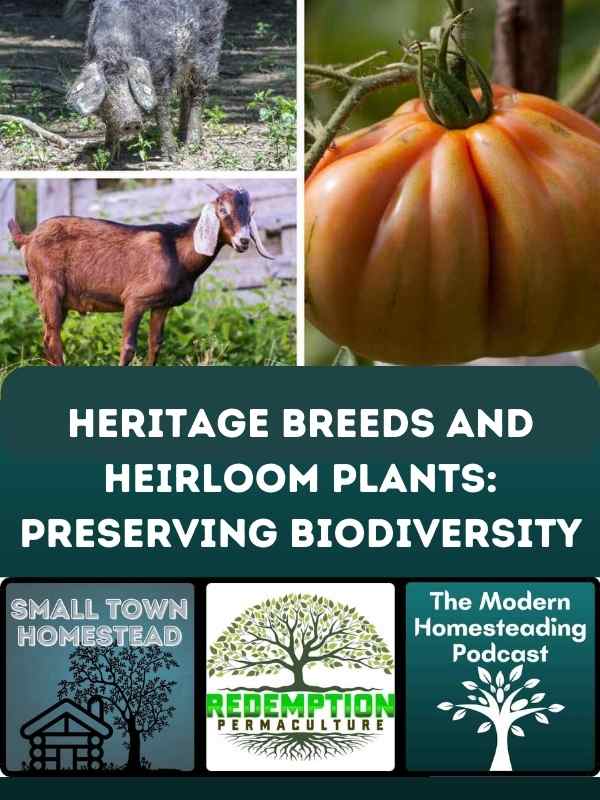In today’s rapidly changing world, the conservation of biodiversity has become a crucial endeavor. One of the lesser-known yet equally important aspects of this effort involves the preservation of heritage breeds and heirloom plants. These timeless treasures of agricultural diversity play a significant role in maintaining genetic variation and ecological resilience.

As modern agricultural practices tend to favor uniformity and efficiency, heritage breeds and heirloom plants stand as living testaments to our agricultural history and offer many benefits that extend far beyond nostalgia. In this article, we will delve into the world of heritage breeds and heirloom plants, exploring their significance, the reasons for their preservation, and practical ways to conserve them on a homestead.
Understanding Heritage Breeds and Heirloom Plants
Heritage breeds and heirloom plants are living links to the past, representing the traditional agricultural practices that have shaped human civilizations for centuries. Heritage breeds refer to livestock species that have been bred over generations for specific traits, adapted to local environments and human needs.
Similarly, heirloom plants are plant varieties that have been passed down through generations, maintaining their unique characteristics that might have otherwise been lost in the wake of modern industrial agriculture.
- D. Phillip Sponenberg (Author)
- English (Publication Language)
- 240 Pages – 05/06/2014 (Publication Date) – Storey Publishing, LLC (Publisher)
Last update on 2024-07-26 / Affiliate links / Images from Amazon Product Advertising API
The Importance of Preservation
Genetic Diversity
Heritage breeds and heirloom plants possess a diverse range of genes that have adapted to various climates, landscapes, and challenges. This genetic diversity is a precious resource that can be tapped into to enhance the resilience of our agricultural systems in the face of changing environmental conditions.
Cultural Heritage
These breeds and plants carry stories of our cultural heritage. They are a living narrative of the close relationship humans have had with the land and the animals they raised for sustenance, companionship, and other needs.
Ecological Balance
Heritage breeds and heirloom plants often thrive in local ecosystems, contributing to ecological balance. Some heritage livestock breeds, for instance, are well-suited to graze in specific habitats, preventing overgrowth and supporting native flora and fauna.
Nutritional Value
Many heritage breeds and heirloom plants offer unique flavors and nutritional profiles that can be a valuable addition to our diets, diversifying our culinary experiences and enhancing our health.
- Hardcover Book
- Etty, Thomas (Author)
- English (Publication Language)
Last update on 2024-07-26 / Affiliate links / Images from Amazon Product Advertising API
Preservation Strategies on a Homestead
Research and Education
The first step in preserving heritage breeds and heirloom plants is to understand their history, traits, and needs. Conduct thorough research or consult local experts to gain insights into the breeds and plants that are best suited for your region.
Choose Purposefully
When establishing a homestead, consider incorporating heritage breeds and heirloom plants into your plan. Prioritize them based on their compatibility with your local environment, the benefits they offer, and your own preferences.
Breeding Programs
If feasible, consider participating in or supporting breeding programs dedicated to preserving heritage breeds. By maintaining healthy populations, we can prevent the loss of valuable genetic traits.
Seed Saving
Heirloom plants rely on the practice of seed saving. Learn how to collect, store, and replant seeds from your heirloom plants to ensure their continuity.
No products found.
Market Demand
Encourage the demand for products derived from heritage breeds and heirloom plants. By creating a market for these products, you contribute to their economic viability and promote their conservation.
Conclusion
In a world marked by rapid changes and growing concerns about sustainability, the preservation of heritage breeds and heirloom plants shines as a beacon of hope. These living legacies not only offer a window into our agricultural past but also hold the keys to building a resilient and diverse future.
By recognizing their importance, making informed choices, and actively participating in their conservation, individuals on homesteads and beyond can contribute to the vital task of preserving biodiversity, one heritage breed and heirloom plant at a time.




